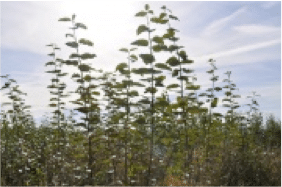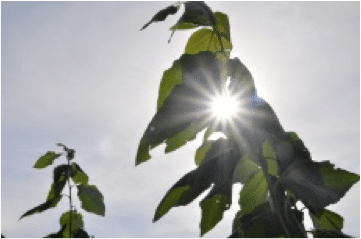What exactly is short rotation forestry?
Interview wird Michael Diekamp
Short rotation forestry (SRF) plantations involve the cultivation of renewable resources and are an important element of Klasmann-Deilmann’s sustainability strategy. In Geeste, the company manages a plantation of this kind on a trial site, with the wood crop used to provide energy to the ‘Werk Nord’ plant in Sedelsberg. SRF now exists on a large scale in Lithuania, providing a sustainable energy source. But why exactly are these plantations climate-friendly, and what is their impact on biodiversity and soil protection? We answer these and other important questions on this topic as part of our series entitled “What Klasmann-Deilmann is doing for sustainability”.
Kim Karotki: What exactly is short rotation forestry (SRF)?
Michael Diekamp: An SRF plantation is at the interface between farming and forestry and originated in traditional coppice management. It involves planting trees on agricultural land to obtain a wood energy crop within a short rotation cycle. “This cycle is the length of time between planting and harvesting. The rotation period in SRF is considerably shorter than in a ‘conventional’ woodland,” says expert Michael Diekamp, who is in charge of Forestry, SRF and Renewable Resources operations at Klasmann-Deilmann. The rotation time of a forest stand is normally at least 100 years, as opposed to mere three years (on average) on a short rotation site. In agriculture, less than one year elapses between sowing and harvest. “Based on current knowledge it is assumed that an SRF plantation can be managed for 20 years, i.e. approximately seven harvest cycles,” Diekamp adds.
Kim Karotki: Which tree species are especially suitable for SRF management?
Michael Diekamp: In principle, any kind of wood is an energy source. To be suitable for SRF use, however, a tree species has to meet certain criteria. Firstly, it needs to grow rapidly in order to maximise the yield within a short time. Secondly, it needs to be able to coppice, which means it forms new shoots from its stump after the above-ground parts of the plant have been harvested. A tree’s capacity to make new growth in this way is a measure of its regenerative capacity. “The dual requirement for fast growth and good coppicing ability is best fulfilled by willows and poplars. So these species are ideal for short rotation plantations,” comments Diekamp.
Kim Karotki: Since when has Klasmann-Deilmann managed SRF plantations, and where?
Michael Diekamp: In Germany, Klasmann-Deilmann began creating its first SRF plantation in 2009 on a 20-hectare area at Schöninghsdorf in the Emsland region, equivalent in size to almost 30 football pitches. Since then, the site has seen regular harvesting: the wood obtained is processed into woodchips that are used to fire the heating system at the Sedelsberg plant. This provides heating for the entire plant, making it self-sufficient in this respect. In Lithuania, the first harvest of an SRF site is currently underway. In the Silute/Taurage region, willows have been planted over a net area of 1,500 hectares, these trees being ideally suited to the prevailing climate in the Baltic states. The aim is to expand this land use to 3,000 hectares by 2016.
Kim Karotki: What makes an SRF plantation sustainable?
Michael Diekamp: Short rotation wood is a carbon-neutral fuel, giving it great future potential as an important energy source. The 2015 climate change conference in Paris showed that fossil fuels no longer have a future. “Of all organic natural resources, SRF wood is the most efficient energy source. This is clearly evident from the climate footprint: no comparable renewable resource involves so much energy output being obtained for so little input,” says Diekamp.
Kim Karotki: What impact does an SRF plantation have on biodiversity and the environment?
Michael Diekamp: An SRF plantation is a much more extensive form of land management than agriculture. Whereas a piece of farmland needs to be ploughed, harrowed and fertilised annually, and herbicides and pesticides also applied every year, a short-rotation site requires these operations only every 20 years. Indeed, Klasmann-Deilmann makes no use of herbicides and pesticides, opting for mechanical weeding. This leads to significant soil protection benefits: the soil structure improves and humus builds up. And, compared with conventional arable cultivation, SRF is also beneficial with regard to biodiversity and better for the environment overall.
Kim Karotki: How much energy does SRF yield?
Michael Diekamp: A 1,000 hectare short rotation site with a three-year harvesting cycle produces 48,000 tonnes of wood for energy purposes. Based on the energy content of poplars, for example, this harvested material yields around 104,000 megawatt hours of energy, enough to cover the annual demand of just under 21,000 four-person households.
Kim Karotki: Why are there so few SRF plantations in Germany?
Michael Diekamp: The reasons for this are chiefly economic. In predominantly farming areas, land prices are high. Another factor is current prices of fossil fuels such as oil and gas, which recently hit an all-time low, and the relatively small demand for heating energy, because of the very mild winters in the past two years. As SRF entails the capital being tied up for a long period, this form of energy production currently does not appear very attractive from a business point of view, despite its being very environmentally and climate friendly. Moreover, in Germany, there is also a certain degree of underlying scepticism about renewable resources as energy sources, which can be traced back to the debate about ‘energy’ maize and the coexistence of biofuels and food.
Kim Karotki: Why are SRF plantations much more widespread in the Baltic region?
Michael Diekamp: In the Baltic states, there is strong political will that the region should be independent of foreign energy sources. Because of public opposition, nuclear energy is very difficult to establish here. On top of this, there is a functioning local heating network and land prices are comparatively low. “For these reasons, combined with advantages in terms of sustainability and climate impact, SRF is a highly attractive and valued form of energy production in the Baltic region,” Diekamp explains.

